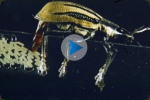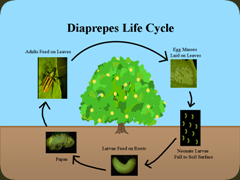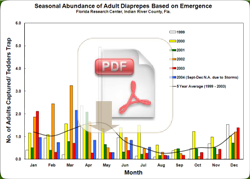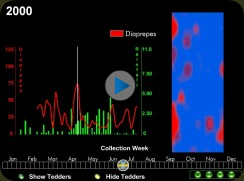Diaprepes

The Diaprepes root weevil (Diaprepes abbreviatus) is the most serious insect
pest of citrus in the United States. This invasive insect was first detected in
the United States in 1964 in Apopka, Florida, and has become established in many
crops in Florida, in including corn, sugarcane, woody ornamentals, and citrus.
Click here to see a Diaprepes
Oviposition video...
FlaRes, working with a variety of collaborators, has investigated and documented
the life cycle and ecology of this terrible pest. FlaRes uses this understanding
to develop, field test, and demonstrate best management practices to control this
pest.
In 1990 FlaRes made the first detection of this pest in Indian River County citrus
in its demonstration groves. Diaprepes root weevil now infests more than 18% of
Floridas commercial citrus acreage, according to Floridas Division of Plant Industry.
Diaprepes causes tree decline and mortality, decreased crop yield, increased production
costs, and reduced packouts, threatening the economic viability of citrus.
In 1993, the Diaprepes Task Force, a coalition of state and federal scientists,
regulatory personnel, and citrus and ornamental growers, was formed "to coordinate
and facilitate research, education and regulatory efforts to manage this pest more
efficiently". Bob Adair, FlaRes Executive Director, has been a member of the Diaprepes
Task Force since 1994.

FlaRes continues to investigate and creatively portray the life cycle of this
pest, to develop best management practices for its control as part of its holistic
Sustainable Citrus Program, and to collaborate in trials to identify resistant rootstocks.
Documenting Abundance: Emergence Graphs

FlaRes monitors and charts the number of Diaprepes root weevils at its demonstration
groves in Vero Beach with Tedders Traps arranged in a diamond-shaped grid. Two graphs
have been created to chart these numbers. One counts the weekly abundance of Diaprepes.
The other compares the numbers of Diaprepes from month to month from 1996 to the
present.
Click here to see graphs...
Toward a Better Understanding of Infestation: Diaprepes Visualization

Little is known about the spatial distribution patterns of Diaprepes or the rate
and direction of spread of Diaprepes root weevil infestations in citrus.
FlaRes has pioneered the use of GIS tools to depict Diaprepes emergence over time
throughout its entire demonstration grove.
Weekly adult weevil emergence data was obtained from georeferenced Tedders Traps
and depicted in traditional Emergence Graphs (see above). To gain a greater
understanding of the emergence of Diaprepes, GIS tools were used to analyze this
data and to provide spatial interpolation of Diaprepes emergence for unmonitored
areas for weekly periods for one to four years (2000‑2003).
Animation software was then utilized to combine the weekly interpolations into an
interactive animation that create a visualization of the spatiotemporal aspects
of Diaprepes emergence throughout the entire grove. In addition, these Diaprepes
abundance interpolations were synchronously aligned with weekly rainfall data.
The resulting interactive animation successfully portrays different geographic and
seasonal aspects of Diaprepes activity and rainfall patterns. This visualization
of the spatiotemporal aspects of Diaprepes emergence facilitates a better understanding
than conventional analysis of tabular or graphed data.
The ability to visualize additional factors such rainfall, soil temperature, or
soil type in conjunction with spatiotemporal emergence will increase our understanding
of the ecology of Diaprepes. This enhanced understanding and insight provides
essential timing and location information necessary for precision application of
crop protectants.
Click here to learn more...
History of Diaprepes Infestation
- 1964: 1st Detected in United States (Apopka, FL)
- 1968: Large Scale Eradication Efforts Attempted
- 1974-84: Loss of Soil Applied Chemicals
- 1990: Diaprepes 1st Detected in Indian River County (Kerr Center, Vero Beach, FL)
- 1994: 15,604 Acres of Citrus Infested (Fla. D.P.I.)
- 1997: 29,767 Acres of Citrus Infested (Fla. D.P.I.)



